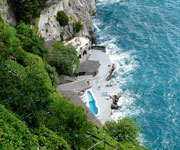Costiera Amalfitana is an outstanding example of a Mediterranean landscape, with exceptional cultural and natural scenic values resulting from its dramatic topography and historical evolution. The area covers 11,231 ha in 15 Communes in the Province of Salerno. Its natural boundary is the southern slope of the peninsula formed by the Lattari hills which, stretching from the Picentini hills to the Tyrrhenian Sea, separate the Gulf of Naples from the Gulf of Salerno. It consists of four main stretches of coast (Amalfi, Atrani, Reginna Maior, Reginna Minor) with some minor ones (Positano, Praiano, Certaria, Hercle), with the mountain villages of Scala, Tramonti and Ravello and hamlets of Conca and Furore behind and above them.

Continent: Europe
Country: Italy
Category: Cultural
Criterion: (II)(IV) (V)
Date of Inscription: 1997
Amalfi was founded in the 4th century AD
Palaeolithic and Mesolithic materials have been found at Positano, and the area was favoured by the Romans, judging from the villas of Positano, Minori and Gallo Lungo. However, it was not intensively settled until the early middle Ages, when the Gothic War made it a place of refuge. Amalfi was founded in the 4th century AD. A new Roman colony in nearby Lucania came under barbarian attack and the inhabitants moved to the fertile and well-watered hilly area around modern Scala. In the first written reference to Amalfi (596) it was already a fortified town and the seat of a bishopric. It resisted Lombard attacks until 838, when it was conquered and looted by Sicardo. However, after his death the following year the town declared its independence.
 |
| Costiera Amalfitana Italy |









No comments:
Post a Comment